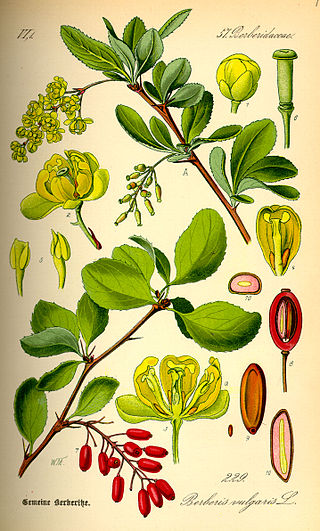
Berberis, commonly known as barberry, is a large genus of deciduous and evergreen shrubs from 1–5 m (3.3–16.4 ft) tall, found throughout temperate and subtropical regions of the world. Species diversity is greatest in South America and Asia; Europe, Africa and North America have native species as well. The best-known Berberis species is the European barberry, Berberis vulgaris, which is common in Europe, North Africa, the Middle East, and central Asia, and has been widely introduced in North America. Many of the species have spines on the shoots and all along the margins of the leaves.

Nicotiana glauca is a species of flowering plant in the tobacco genus Nicotiana of the nightshade family Solanaceae. It is known by the common name tree tobacco. Its leaves are attached to the stalk by petioles, and its leaves and stems are neither pubescent nor sticky like Nicotiana tabacum. It resembles Cestrum parqui but differs in the form of leaves and fusion of the outer floral parts. It grows to heights of more than two meters.

The University of Delaware Botanic Gardens are botanical gardens and an arboretum located on the campus of the University of Delaware, in Newark, Delaware, United States. The gardens are open to the public without charge.

The Berberidaceae are a family of 18 genera of flowering plants commonly called the barberry family. This family is in the order Ranunculales. The family contains about 700 known species, of which the majority are in Berberis. The species include trees, shrubs and perennial herbaceous plants.

Peavy Arboretum is an arboretum operated by Oregon State University and located on Arboretum Road, Corvallis, Oregon. It is open to the public daily without charge.

Berberis vulgaris, also known as common barberry, European barberry or simply barberry, is a shrub in the genus Berberis native to the Old World. It produces edible but sharply acidic berries, which people in many countries eat as a tart and refreshing fruit.

The golden-eyed flowerpiercer, also known as the deep-blue flowerpiercer, is a species of bird in the tanager family Thraupidae. It is found in humid Andean forests in Colombia, Ecuador, Peru and Bolivia. It is the only species of flowerpiercer with bright yellow eyes.
Berberis farinosa is a species of plant in the family Berberidaceae. It is endemic to Ecuador. Its natural habitat is subtropical or tropical high-altitude grassland. It is threatened by habitat loss.
Berberis jamesonii is a species of plant in the family Berberidaceae. It is endemic to Ecuador. Its natural habitat is subtropical or tropical high-altitude grassland.
Berberis laidivo is a species of plant in the family Berberidaceae. It is endemic to Ecuador. Its natural habitat is subtropical or tropical high-altitude grassland.
Berberis lechleriana is a species of plant in the family Berberidaceae. It is endemic to Ecuador.
Berberis minzaensis is a species of plant in the family Berberidaceae. It is endemic to Ecuador. Its natural habitats are subtropical or tropical high-altitude shrubland and subtropical or tropical high-altitude grassland. It is threatened by habitat loss.
Berberis pavoniana is a species of plant in the family Berberidaceae. It is endemic to Ecuador. Its natural habitat is subtropical or tropical high-altitude grassland.
Berberis pectinata is a species of plant in the family Berberidaceae. It is endemic to Ecuador.
Berberis pindilicensis is a species of plant in the family Berberidaceae. It is endemic to Ecuador. Its natural habitat is subtropical or tropical moist montane forests. It is threatened by habitat loss.
Berberis schwerinii is a species of plant in the family Berberidaceae. It is endemic to Ecuador. Its natural habitat is subtropical or tropical high-altitude grassland.
Berberis simonsii is a species of plant in the family Berberidaceae. It is endemic to Ecuador.
Berberis standleyi is a shrub in the Berberidaceae described as a species in 1952. It was published with the name Mahonia glauca, a very different plant from Berberis glauca. Thus if one desires to consider Berberis and Mahonia as one genus instead of two, it is necessary to use a different name, i.e. Berberis standleyi.
Berberis quindiuensis is a shrub in the family of Berberidaceae described as a species by Carl Sigismund Kunth in 1821. It is native to the Boyacá department of Colombia.





